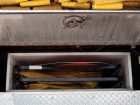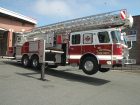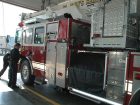
Features
Training
Back to Basics: February 2015
An apparatus driver helps to set the tone of a rescue or fire-ground operation. How the driver positions the apparatus at a scene is crucial to a successful fire-ground operation or motor-vehicle rescue.
February 5, 2015
By Mark van der Feyst
The two main locations at which firefighters operate are the structural fire ground (both for municipal and rural areas) and highways or roadways for vehicle incidents.
For the driver, understanding the operational differences between these scenes is important from a safety standpoint.
The location of the fire truck affects how well the team operates. The position of the apparatus usually dictates which tactics are used to combat the fire or emergency.
While determining the exact position of apparatus is up to the driver, the officer and the driver should work together in advance to determine which operations will be needed so that the apparatus can be parked in the most effective spot.
Ineffective parking can hinder fire-service operations. Consider a scenario involving ground ladders. Truck/engine companies sometimes store ground ladders in enclosed compartments inside the apparatus so that the ladders are protected from dirt and stay clean.
To remove the ground ladders from the truck, they must be pulled out completely from the compartment. A 7.3-metre (24-foot) extension ladder is 4.3 metres (14 feet) long when bedded and needs about 4.6 metres (15 feet) of space to be pulled from the storage compartment.
If the space between two trucks or a truck and a building or obstruction is too small, firefighters will not have room to pull a ground ladder off the truck. The driver must ensure that he or she leaves enough space between trucks so that ground ladders can be removed.
The same goes for remote arms built into an apparatus to bring down a ladder from the top or from the side; the arms must have enough space to operate and enough space to pull the ladder off.
The same caution must be used when operating portable water tanks – which are sometimes located on the side of the fire trucks – particularly if a truck uses a remote arm to bring down the tank.
In photo 1, the water tank is stored inside a compartment of the truck. It is crucial that the driver know the length of the water tank when parking the truck behind another one so that there’s enough space for firefighters to pull off the water tank.
In a similar way, drivers of aerials must leave enough space for the outriggers (see photo 2). The driver must either know the distance required for the outriggers to fully deploy, or avoid parking two trucks side by side.
Drivers should also know the length of the aerial when it’s completely bedded (see photo 3). This is important in case the aerial device is needed during a structural incident for access to the first-floor windows for water delivery.
If there is not enough room between the building and the aerial apparatus, then the aerial ladder cannot be used for front-building access.
When firefighters arrive at a home or building that is located close to the street, the first-arriving apparatus needs to be positioned to allow access to the building for aerial operations or ground-ladder operations.
If the first arriving apparatus is an engine or a pumper, the driver should pull it past the address so that the front of the building is open; doing so allows the aerial device to have full access to the front and or sides of the building without obstruction.
Pulling past the address also allows the officer to quickly see three sides of the building for size-up.
When the driver pulls an apparatus past the building, the truck should end up with the tailboard just past the corner of the building; this also allows for a ground-ladder operation in front of the building. When the fire apparatus is parked in the way it prevents the use of ground ladders to access second or third-storey windows.
As well, exposing the front of the building by pulling past it allows for unimpeded hose advancement into the structure. When a hoseline has to snake its way around fire trucks and then into the building, it cuts down on some of the length available for advancement.
As a driver, take an extra second or two to determine the best place to park the apparatus so that the operation is efficient and effective operation from start to finish.
Mark van der Feyst has been in the fire service since 1999 and is a full-time firefighter in Ontario. Mark teaches in Canada, the United States and India. He is a local-level suppression instructor for the Pennsylvania State Fire Academy and an instructor for the Justice Institute of BC. He is also the lead author of Pennwell’s Residential Fire Rescue book. Email Mark at Mark@FireStarTraining.com
Print this page


